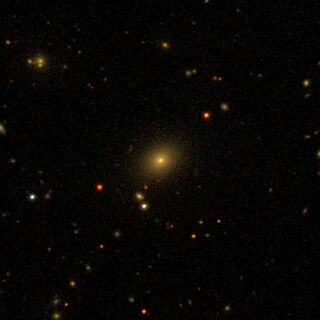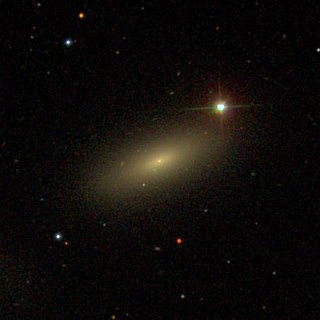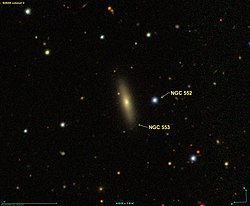
NGC 500(also known as PGC 5013) is a type E-SO lenticular galaxy located in the Pisces constellation. It has an apparent size of .8 by .6 arcminutes and an apparent magnitude of 14.2. It was first discovered in 1850 by Bindon Blood Stoney during his time at Birr Castle in Ireland.

NGC 203 is a lenticular galaxy located approximately 233 million light-years from the Solar System in the constellation Pisces. It was discovered on December 19, 1873 by Ralph Copeland.

NGC 507, also known as Arp 229, CGCG 502-67, MCG 5-4-44, PGC 5098, UGC 938, and V V 207, is a lenticular galaxy in the constellation Pisces. It was described as being "very faint", "pretty large", "round", "brighter in the middle", and "south of NGC 508" by John Dreyer in the New General Catalogue. The two galaxies are a part of the Atlas of Peculiar Galaxies, where NGC 507 is described as "Circular or near circular rings of small density difference."

NGC 463 is a lenticular galaxy located about 264 million light-years away from Earth in the constellation Pisces. It was discovered by French astronomer Édouard Stephan on December 16, 1871.

NGC 4620 is a lenticular galaxy located about 65 million light-years away in the constellation of Virgo. It was discovered by astronomer John Herschel on March 29, 1830. NGC 4620 is a member of the Virgo Cluster.

NGC 475 is a lenticular galaxy in the constellation Pisces. It is located approximately 750 million light-years from Earth and has a diameter of roughly 125 thousand light-years. NGC 475 was discovered on November 3, 1864 by German astronomer Albert Marth.

NGC 4436 is a lenticular or dwarf elliptical galaxy located about 60 million light-years away in the constellation of Virgo. NGC 4436 was discovered by astronomer William Herschel on April 17, 1784. The galaxy is a member of the Virgo Cluster.

NGC 490, also occasionally referred to as PGC 4973 or GC 277, is a lenticular galaxy in the constellation Pisces. It is located approximately 85 million light-years from Earth and was discovered on December 6, 1850, by Irish engineer Bindon Blood Stoney. Although John Dreyer, creator of the New General Catalogue, credits the discovery to astronomer William Parsons, he notes that many of his claimed discoveries were made by one of his assistants. In the case of NGC 490, the discovery was made by Bindon Stoney, who discovered it along with NGC 486, NGC 492 and NGC 500 during his observation of NGC 488.

NGC 4503 is a barred lenticular galaxy located around 41 to 74 million light-years away in the constellation Virgo. NGC 4503 was discovered by astronomer William Herschel on March 15, 1784. NGC 4503 is a member of the Virgo Cluster.

NGC 499, also occasionally referred to as PGC 5060, IC 1686 or GC 289, is a lenticular galaxy in the constellation Pisces. It is located approximately 197 million light-years from the Solar System and was discovered on 12 September, 1784 by astronomer William Herschel.

NGC 498 is a lenticular galaxy located about 260 million light-years away from Earth, in the constellation Pisces. NGC 498 was discovered by astronomer R. J. Mitchell on October 23, 1856.

NGC 505 is a lenticular galaxy approximately 234 million light-years away from Earth in the constellation of Pisces. It was discovered by German astronomer Albert Marth on October 1, 1864.

NGC 502, also occasionally referred to as PGC 5034 or UGC 922, is a lenticular galaxy in the constellation Pisces. It is located approximately 113 million light-years from the Solar System and was discovered on 25 September 1862 by German astronomer Heinrich Louis d'Arrest. When the Morphological Catalogue of Galaxies was published between 1962 and 1974, the identifications of NGC 502 and NGC 505 were reversed. In reality, NGC 502 is equal to MGC +01-04-041 and not MCG +01-04-043 as noted in the catalogue.

NGC 504, also occasionally referred to as PGC 5084 or UGC 935, is a lenticular galaxy located approximately 189 million light-years from the Solar System in the constellation Pisces. It was discovered on 22 November 1827 by astronomer John Herschel. The object was listed twice in the General Catalogue, precursor of the New General Catalogue, as both GC 291 and GC 292.

NGC 515, also occasionally referred to as PGC 5201 or UGC 956, is a lenticular galaxy located approximately 228 million light-years from the Solar System in the constellation Pisces. It was discovered on 13 September 1784 by astronomer William Herschel.

NGC 517, also occasionally referred to as PGC 5214 or UGC 960, is a lenticular galaxy located approximately 188 million light-years from the Solar System in the constellation Pisces. It was discovered on 13 September 1784 by astronomer William Herschel.

NGC 525, also occasionally referred to as PGC 5232 or UGC 972, is a lenticular galaxy located approximately 95.6 million light-years from the Solar System in the constellation Pisces. It was discovered on 25 September 1862 by astronomer Heinrich d'Arrest.

NGC 709 is a lenticular galaxy located 150 million light-years away in the constellation Andromeda. It was discovered by the Irish engineer and astronomer Bindon Blood Stoney on October 28, 1850 and is a member of the galaxy cluster Abell 262.

NGC 717 is a lenticular galaxy located 210 million light-years away in the constellation Andromeda. The galaxy was discovered by astronomer Bindon Blood Stoney on October 28, 1850 and is a member of Abell 262.

NGC 7838 is a spiral or lenticular galaxy located about 500 million light-years away in the constellation of Pisces. The galaxy was discovered by astronomer Albert Marth on November 29, 1864. NGC 7838 appears to interact with NGC 7837 forming Arp 246.



















